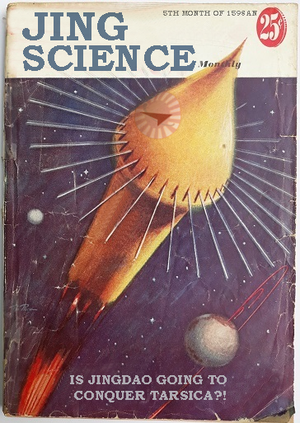Jingdaoese Aerospace Exploration Agency
| Jin kōkū uchū tansa kikan | |
 | |
| Abbreviation | JAXA |
|---|---|
| Headquarters | Daocheng, Jingdao |
| Budget | classified |
The Jingdaoese Aerospace Exploration Agency (ジン航空宇宙探査機関), abbreviated JAXA is the Jingdaoese national aerospace and space agency. It cooperates closely with the Common Cosmos Colonization Coalition, as part of a shared effort to explore space. Several of its inventions are meant for commercial use, meant to improve the citizens' ways of life.
History
The organisation's roots can be traced back as far as 1526 AN and precedes the establishment of Jingdaoese dominance on the Apollonian continent. It's the spiritual successor of the Batavian space program (the Batavian Space Association), which successfully launched a series of Nepton-series satellites between 1526 and 1533 AN. With the collapse of Batavia, the know how and possession of those satellites and the (resource) material was taken to Jingdaoese laboratories and agencies.

Between 1598 and 1601 AN, the first Jingdaoese manned flights were launched with special support from private investors and the local administration of Zeeburg. The Uminohashi I acted as an unmanned test flight, while the Uminohashi II brought a Jingdaoese dog (rescued from being eaten) into space. Eventually it was the Uminohashi III and Uminohashi IV which brought Jingdaoese into space (making a round around the world). An accident with the Uminohashi V and financial restrictions ended further space travel.
The start of the 17th century saw the urgent replacement of the old-fashioned Nepton-satellites with the Gorubaru-series (mainly used to assure Jingdaoese independence from others countries concerning gps and communications) during the reign of the Duchang Emperor. Limited funds and attention from the authorities brought further research to a stalemate. Only after the liberation of Kildare and the establishment of a strong powerbase over most of western Apollonia, the military began to see the advantage of investing in space projects.
The high costs, combined with fear for Natopian superiority in space technology, led to a slow but steady progress in further research. Not wanting to incite a space race it could - at that time - not win against the Raspur Pact, focus remained on unmanned communication and spy satellites.
The Kalirion Fracture in 1671 AN, boosted public morale and further increased a sense of superiority among the Jingdaoese population, after the War of Lost Brothers. The country had had a short-lived economical crisis after the war, but had survived - and even flourished, thanks to increased investments into the Union. The collapse of the - in Jingdaoese eyes' - evil imperialist state, strengthened the belief that Jingdao and its allies were on the right track. Swept away in the positivism, the Grand Secretariat decided to cooperate with its fellow Union States. The Common Cosmos Colonization Coalition was established.
From 1671 to 1674 AN, the Uchuhiku-series was launched, the first manned flights in 70 years, as part of preparations of establishing the Orbital Command.
Space programs
Nepton-series (1526 - 1533)
| Mission | Type | Start date | End date | Status | Notes |
|---|---|---|---|---|---|
| Nepton I - Alfa | unmanned (satellite) |
1526 AN | 1526 AN | Inactive | First mission, launched as Batavian Space Association. First round around Micras. Return to Micras failed. |
| Nepton I - Beta | unmanned (satellite) |
1527 AN | 1527 AN | Inactive | Launched as Batavian Space Association. Second round around Micras' orbit. Return to Micras successful. |
| Nepton I - Gamma | unmanned (satellite) |
1529 AN | 1529 AN | Inactive | Launched as Batavian Space Association. |
| Nepton I - Delta | unmanned (satellite) |
1530 AN | 1531 AN | Inactive | Launched as Batavian Space Association. |
| Mission | Type | Start date | End date | Status | Notes |
|---|---|---|---|---|---|
| Nepton II-A | unmanned (satellite) |
1527 AN | 1596 AN | Inactive | Communication satellite. |
| Nepton II-B | unmanned (satellite) |
1527 AN | 1585 AN | Inactive | Communication satellite. |
| Nepton II-C | unmanned (satellite) |
1527 AN | 1599 AN | Inactive | Communication satellite. |
| Nepton II-D | unmanned (satellite) |
1528 AN | 1601 AN | Inactive | Communication satellite. |
| Nepton II-E | unmanned (satellite) |
1532 AN | 1606 AN | Inactive | Communication satellite. |
| Nepton II-F | unmanned (satellite) |
1532 AN | 1606 AN | Inactive | Communication satellite. |
| Nepton II-G | unmanned (satellite) |
1533 AN | 1606 AN | Inactive | Communication satellite. |
Uminohashi-series (1598 - 1601)
- Uminohashi I: 1598
- Uminohashi II: 1598
- Uminohashi III: 1599
- Uminohashi IV: 1600
- Uminohashi V: 1601